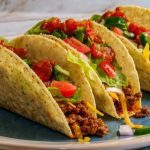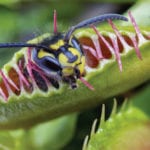 History
History  History
History  Technology
Technology Top 10 Everyday Tech Buzzwords That Hide a Darker Past
 Humans
Humans 10 Everyday Human Behaviors That Are Actually Survival Instincts
 Animals
Animals 10 Animals That Humiliated and Harmed Historical Leaders
 History
History 10 Most Influential Protests in Modern History
 Creepy
Creepy 10 More Representations of Death from Myth, Legend, and Folktale
 Technology
Technology 10 Scientific Breakthroughs of 2025 That’ll Change Everything
 Our World
Our World 10 Ways Icelandic Culture Makes Other Countries Look Boring
 Misconceptions
Misconceptions 10 Common Misconceptions About the Victorian Era
 Mysteries
Mysteries 10 Strange Unexplained Mysteries of 2025
 History
History 10 Things You Didn’t Know About the American National Anthem
 Technology
Technology Top 10 Everyday Tech Buzzwords That Hide a Darker Past
 Humans
Humans 10 Everyday Human Behaviors That Are Actually Survival Instincts
Who's Behind Listverse?

Jamie Frater
Head Editor
Jamie founded Listverse due to an insatiable desire to share fascinating, obscure, and bizarre facts. He has been a guest speaker on numerous national radio and television stations and is a five time published author.
More About Us Animals
Animals 10 Animals That Humiliated and Harmed Historical Leaders
 History
History 10 Most Influential Protests in Modern History
 Creepy
Creepy 10 More Representations of Death from Myth, Legend, and Folktale
 Technology
Technology 10 Scientific Breakthroughs of 2025 That’ll Change Everything
 Our World
Our World 10 Ways Icelandic Culture Makes Other Countries Look Boring
 Misconceptions
Misconceptions 10 Common Misconceptions About the Victorian Era
 Mysteries
Mysteries 10 Strange Unexplained Mysteries of 2025
Top 10 Popular Foods That Aren’t What You Think
Like many things in the modern world, we are often overwhelmed by choices when we go out in public to buy things. Especially if you live in the United States, you will find yourself with so many choices it can actually be a bit too much. In this giant morass of processed food, it is easy for us to get confused and not realize half the time what is going on with what we are buying unless we do a lot of research.
As most of us are busy people, we don’t usually have a lot of time to research literally every product we buy, so some things sneak past us regardless of how smart we are. And unfortunately, the grocery store is full of products that are fake, misleadingly advertised, or just not what you thought they were.
Related: Top 10 Bizarre Cancelled Food Products
10 Honey
Honey is one of the most popular confectionery flavors, and we all know and love the taste. It is a worldwide commodity and is treasured not just for its taste but also for the fact that it is low on the glycemic index and has natural antibiotic properties. Most people keep honey on their shelves, and many go for the cheaper stuff, figuring it may not be particularly high-quality honey, and it may even be processed, but at least it is still real honey.
However, the unfortunate reality is that unless you know your source really well and are probably paying a premium for it, you may not be getting genuine honey at all. It turns out that adulterated or even just plain counterfeit honey is incredibly common, and this has been backed up by studies over the years. Studies estimate that one-third of the honey sold worldwide is counterfeit. Also, in Europe, they have an even bigger problem, with only 50% being the genuine article. Your best bet is to look for raw honey from a local supplier, such as a farmers market.[1]
9 Olive Oil
Olive oil is easily one of the most common staple products in the world, and most of us have some in our kitchens right now. It is known for being incredibly healthy, has a mild taste, and is greatly associated with Italian-style cooking, which has become popular worldwide. And, of course, as we all know, there is a huge variety when we go to the grocery store. We will find dozens of brands, all claiming to be high-quality extra virgin olive oil, and it can be confusing what to buy.
This becomes even more confusing because the Italian mafia has actually been behind counterfeit olive oil for years and is tricking you into buying cut, fake, or low-quality products. This problem is hard to define for sure, as the mafia isn’t going to tell us just how much counterfeit olive oil they are making, but some experts think the amount is as high as 80% of olive oil on store shelves worldwide. Some experts believe this is an overestimation when it comes to a product that is actually fake or mostly cut, but they concede that the number is likely accurate if you are counting low-quality products being sold as extra virgin.[2]
8 Anything “Chocolaty”
As chocolate becomes more expensive around the world, companies are trying to find new and interesting ways to provide us with the chocolate flavor we love at a price point we can afford without sacrificing too much on taste. This has led to failed products like aerated chocolate, which tried to give us candy with air whipped in it so we wouldn’t realize it didn’t have as much chocolate in it. They have also experimented more with taking small amounts of real chocolate, along with chocolate flavoring, to bridge the gap between taste and cost.
Now, if a product doesn’t contain at least 10% chocolate, it cannot be called chocolate in the United States. There are even stricter rules for candies or products advertised as milk, white, or dark chocolate. However, if you call a product “chocolaty,” you can make it sound to consumers who aren’t paying close attention like you have a more chocolate-based product when you only have a very small amount of real chocolate and a lot of artificial or natural flavorings.[3]
7 Apples
Along with bananas and oranges, apples are one of those fruits that are a staple of most American diets and something we all know very, very well. There are dozens of varieties of apples; they are great for pies or even making booze, and pretty much everyone has a favorite variety. Most of us never spend time thinking about where all these varieties come from, but most would likely be a bit surprised if they found out.
The truth is that all red delicious apples you eat are clones of other red delicious apples, and so on for other varieties. This means most apple varieties were not created using any strange laboratory techniques but by allowing apple trees to regularly grow, producing new variety after new variety to experiment with. Once a grower finds a new variety they like, they graft a branch from the good tree to a new sapling, cloning the same apples over and over again. This means it is actually easier to create new varieties of apples than to maintain old ones, as all you have to do is let a tree grow normally.[4]
6 Most Blueberry Products
Blueberry is an incredibly popular berry and also an incredibly popular flavor in all kinds of confectionery products, from muffins to donuts and everything in between. One of the things that likely makes these products so attractive to the consumer is that they are still billed as “blueberry” and yet do not break the bank. This is rather important as blueberries are one of the most expensive berries on the market and require quite a few to impart a strong blueberry flavor.
Many blueberry products show pictures of what look like little blueberry pieces, and even though the package doesn’t say so, consumers often assume these are little bits of real blueberry. Some people even accept that most of the flavoring may be artificial, but they still think these bits are real.
Unfortunately, those little blueberry bits are actually an amalgamation of sugar, flour, preservatives, food dye, and flavorings. This is a form of legal lying, or legal trickery at the very least, as companies are not technically saying their products have real blueberries. Still, the packaging and pictures often mislead people into thinking otherwise.[5]
5 Artificial Banana Flavoring
Bananas are easily the most popular item in the produce section and the most-eaten fruit worldwide. We all know exactly what a banana tastes like, and we all imagine that we could easily pass a taste test on whether something is a banana or not. For this reason, it is a mystery to some people how researchers who make artificial flavorings managed to do so badly when it comes to banana flavoring. Food scientists are usually quite good at getting at least somewhat close to the flavor of the item they are mimicking. Still, when it comes to bananas, it seems incredibly off.
Most assume bananas are just hard to mimic when it comes to fake flavorings, but the truth is actually a bit stranger. Back in the 1930s, bananas were first starting to become popular, and food scientists had a different banana to work with, known as the Gros Michel. This banana is now mostly extinct and replaced in our taste buds by the now ubiquitous Cavendish banana. This means that artificial banana is actually a pretty decent doppelganger, just not for the type of banana we eat today.[6]
4 Sandwich Cookies
Oreo and other generic sandwich cookies are easily the most popular cookies in America on the store shelf, right next to chocolate chip cookies of every kind. They are sold in tons of flavor varieties, but the creme filling is the main thing in every Oreo or sandwich cookie. That creme filling is so popular some people admit they really don’t even like the cookie that much and just want the filling. And whether they have allergies or diet reasons to worry about it or not, most people assume sandwich cookies contain dairy.
However, while they are not particularly healthy for you, sandwich cookies are actually vegan. The reason for this is the same reason that we carefully wrote the filling of the sandwich cookies as “creme,” which is also how they are listed on the sandwich cookie packaging. You see, the filling in sandwich cookies is called creme filling because it contains no dairy whatsoever. While there are many preservatives and flavorings as well, the base of the filling is mostly just vegetable shortening and sugar.[7]
3 Saffron
Saffron is a spice most of us don’t eat, as it is incredibly expensive at the grocery store. You should expect to pay at least ten dollars just for one gram. Now, sometimes at the cheaper grocery stores, you may see saffron sold for a lower price and just assume it is slightly lower grade, or that it may not have been dried as well, or something of the like. You may even think that this is now your chance to give it a try and figure out everything has to go on sale now and then.
However, sadly, if you bought cheap saffron in a discount store or market, it may not have been real, or at least could have been adulterated. While data on many countries is hard to find, a study of saffron in India, the world’s spice hub, found only about 52% of saffron was real and advertised as per the label. The rest was fake, low quality, or adulterated. It is easily the most faked spice worldwide, and this is because of its difficulty in production. Saffron must be farmed, harvested, and cured manually, making it next to impossible to bring down the cost.[8]
2 Fresh Fish
Fresh fish is already one of the strangest items that you see at the grocery store, owing to the idiosyncrasy of fresh fish to begin with. While it may or may not reach temperatures at or below freezing, most fish is placed on ice to display and is put on ice immediately when a fisherman catches it. However, most of us just accept this as how fish works and get the stuff as it is the freshest we are going to get our hands on.
We tend to be more concerned with what we buy being what it says it is in terms of the type of fish and whether it is sustainable or not. This is unfortunate, as studies have shown that a lot of fish at the supermarket is mislabeled. Two separate studies that tested fish in the grocery store found that a lot of fish was being mislabeled as other fish or was being labeled as sustainably caught when it actually was not. One study found 30%, and another study found 21% as not being what they were labeled. Averaging this out, it means about one-quarter of fish is not what it is labeled as.[9]
1 Subway Tuna
First, Subway had to weather a controversy about an ingredient named azodicarbonamide that is sometimes found in yoga mats and also in some bread products. Now, they are dealing with an ongoing lawsuit that alleges that Subway’s tuna is not actually tuan at all, but some other, less expensive fish that they are passing off as tuna in order to trick the consumer and con them out of their hard-earned money.
This ongoing mess has had independent outlets testing Subway tuna in labs in an attempt to find out if the claims were true or not while we wait for the court case to conclude. Out of notable outlets, the New York Times looked into the controversy and tested Subway’s tuna with inconclusive results. The test was not able to identify tuna DNA, but the tuna was already cooked, which makes the test mostly worthless to begin with.
To properly find out, the judge will likely have to order a test of the tuna at the cannery before it is cooked, as there is no other way to know for sure. What is true is that Subway’s tuna salad is just (alleged) tuna fish and mayonnaise, with employees reporting a fifty-fifty ratio.[10]








